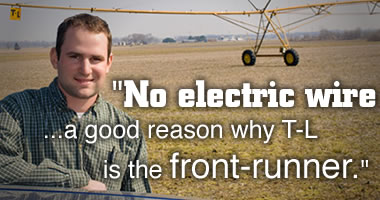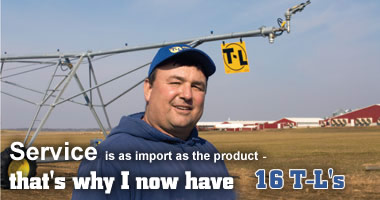 |
Allendale, Illinois |
 Brothers Jim and John Stevens utilize ten T-L and eight electric center-pivot sprinkler systems on their 4,000-acre farm near Allendale, Illinois. Their first experience with irrigation goes back 20 years when a new piece of land came equipped with an electric pivot system.
Brothers Jim and John Stevens utilize ten T-L and eight electric center-pivot sprinkler systems on their 4,000-acre farm near Allendale, Illinois. Their first experience with irrigation goes back 20 years when a new piece of land came equipped with an electric pivot system.
“After about the second year of acquiring more land and irrigating we began adding T-Ls,” Jim points out. “You can ask how many electric pivots have we have replaced with T-L systems and get a quick answer, all we can!”
“Service was a big reason and safety was a factor, too,” John adds. “Now, of course, there’s also the copper wire theft problem. There’s no copper wire on a T-L as there is with every electric pivot system.”
Stealing copper wire from electric center-pivots is unfortunately what they term “common” in their area now. Many of their neighbors have been hit, some twice on the same system.
“One of our neighbors even had the copper wire stolen while the system was watering the crop,” Jim relates. “In fact, they didn’t even shut the engine off. The thieves just pulled back the clutch and let the engine run while they stripped off the copper wire.”
The Stevens have only suffered one loss so far, which they regard as one too many. This electric pivot system was located right by a highway, too. When tile installers attempted to move it last fall they immediately reported, “We can’t move the pivot. The wiring’s gone.”
The thieves had cut the wire into five-foot lengths, then rolled it up and secured the roll with duct tape. The Stevens know this, because one roll was left behind. The brothers say they intend to keep it as a “souvenir”.
To prevent further thefts they’re following a two-step program, banding the copper wiring more securely onto their other electric pivots making it more difficult to remove and replacing electric pivot systems with T-Ls since they don’t require any copper wire to operate.
“A T-L pivot definitely pays off pretty well,” Jim believes. “It depends on the soil type, but we feel the T-L system will pay off in three or four years. And, in dry times,that’s probably more like two years.”
As an example, he notes that on much of their ground irrigation increases their corn yields 100 to 150 bushels an acre. “On dry corners yields may drop down to 50 bushels an acre, yet out in the field we can be making 200 bushels an acre,” he continues.
“Irrigation has also allowed us to double-crop beans and wheat and pretty much guarantee us crops.Irrigation has definitely increased the productivity of our farm ground.”
Since most maintenance and repair work is done by family members, safety is one of their main considerations. As John says, “With T-Ls we don’t have to be worried about anybody being electrocuted.”
“We’ve not had many problems with our T-L systems,” he continues, “it’s usually an engine’s shut down or an old tire that’s gone flat. Over the years we’ve had to replace only three gearboxes.”
In the long run there’s less maintenance with a T-L since it’s stronger and it’s simple to operate. “There’s a lot more maintenance on an electric system,” his brother agrees.
The Stevens brothers also appreciate the built-in hydraulic jacks on their tow able T-Ls. “By running one pivot on two circles, it halves our investment. We can get a tow able T-L moved in an hour or so,” Jim says.
“We also have a tow able electric system, but we don’t tow it anymore since it always falls off the jack a time or two and therefor takes longer to move. We finally moved it to where we could just leave it, since moving it wasn’t worth the effort,” Jim says. “We think our T-Ls are great!”
 |
Vincennes, Indiana |
 “It all started the winter of 2006-2007”, says Matt Richardville who remembers that season well. “That’s when the price of copper began rapidly rising.” It’s also the time that when they checked their fields in early spring they found that all the copper wire had been stripped off their electric center-pivot systems.
“It all started the winter of 2006-2007”, says Matt Richardville who remembers that season well. “That’s when the price of copper began rapidly rising.” It’s also the time that when they checked their fields in early spring they found that all the copper wire had been stripped off their electric center-pivot systems.
“Thieves stole the copper wire from all of our 25 electrics, and later hit one again after the wire had been replaced!” he exclaims. Richardville is part of JMR Farms, a Vincennes, Indiana, family farm corporation. They farm 4,300 acres, most of which is irrigated and using conventional tillage.
Their principle crops are wheat, field corn, and soybeans. They also produce vegetables including sweet corn and 500 acres of potatoes. JMR Farms irrigation began in the 1950s with pipe and gravity, with the first pivot irrigation system being installed almost 40 years ago.
Since three-quarters of the land they farm is rented, the number of T-L pivots they operate may vary from year to year, from nine to 12. All but one of the electric pivots hit by thieves were owned by landlords.
“A local scrap yard told me that wire thieves might make $1,500 to $2,000 from a 1,000-foot electric center-pivot,” Richardville says. “Apparently some people would rather steal copper wire than get an honest job.”
So far this winter five electric systems have been stripped, one nine-tower unit twice. Wire replacement can total up to $12,000. Last summer thieves even stole the copper wire from a system while it was irrigating!
Richardville checked it at 7:30 p.m. and by 5:30 a.m. the next morning the engine was still running, but the copper wire was long gone. “It’s not just the wiring that’s stolen; sharp thieves also know that electric motors are coiled with copper”, he says, “perhaps as much as three pounds of copper in each motor.”
Matt thinks that with such a chronic problem, insurance companies are certain to become reluctant to pay claims. The result almost certainly will be increased rates at best or discontinuance of coverage at worst. JMR Farms has attempted to deter being robbed by putting steel bands around the copper wiring on their electric pivot systems.
However, as Richardville points out, “If the thieves are determined enough, they can always find a way to steal wire. Some farmers have even put barbed wire around their pipes. But, that’s both expensive and time-consuming.”
As the surest solution, he says, “Is to buy a different center-pivot system with no electric wire, and this is a good reason why T-L is the front-runner.” The farm’s first T-L center pivot is now 18 years old.
Richardville says that while at that age some maintenance is required, such as replacing dry hoses, the gearboxes and hydraulic motors have held up quite well. “T-L pivots are built a little bit heavier than other systems,” he says.
“We’ve had seven electric systems blown over by straight winds, but we’ve never had a T-L system flip over. It’s seems the lighter electric systems are more prone to such damage.”
“T-Ls are also the simplest system to operate and their continuous movement helps with ruts in the field, too, since a T-L doesn’t stop and start all the time.”
“And, you don’t have to be an electrician to work on a T-L,” he adds. “I’m not nervous working on a T-L in the field, because I don’t have to work around all that electricity.” He sums up his impression of T-L pivot systems by calling them, good, solid systems that the average farmer can understand even if he’s never run a center-pivot before.
“Also, as far as copper theft goes, T-Ls not having wire is really a strong selling point for them nowadays.” The irrigation water in the area has a high mineral content, especially iron, which quickly discolors the systems, according to Matt Richardville who’s shown in the photographs. Note that the two systems in the background are the initial T-Ls installed on the farm 18 years ago. In the background also are the farm’s 550,000 bushels of grain storage.
 |
Lawrenceville, Illinois |
 “What first caught my interest about T-Ls was, number one, service. I believe that service is as important as the product-which is why I now have 16 T-Ls,” J. R. Thompson in Lawrenceville, Illinois explains.
“What first caught my interest about T-Ls was, number one, service. I believe that service is as important as the product-which is why I now have 16 T-Ls,” J. R. Thompson in Lawrenceville, Illinois explains.
He farms approximately 2,500 acres of corn, wheat, soybeans, green beans, and seed corn. Depending on soil type and slope, he utilizes conventional-till, minimum- till, or no-till. He also handles and feeds under contract 12,000 weaning-to finish hogs annually.
Under critical weather conditions, such as when it’s 95 degree fahrenheit and the wind’s blowing 30 miles an hour, Thompson says, “We can’t stand much down time if we’re trying to produce a crop.
“Here’s an example of my T-L dealer service I’ve received, at 9 p. m. or 10 p.m. one hot summer day I found I needed some parts for a pivot. I talked to the dealer’s wife, who was able to get hold of him at a meeting. I had my parts and was able to get the system up and running yet that evening. That’s service.”
Thompson is convinced that with his area’s soil types farmers can produce crop yields comparable with anybody in the country.
“What does irrigation do for me?” he asks. “One hundred bushels of corn an acre more. I can honestly say that over a five-year period I probably average 125 bushels of corn dryland versus 225 bushels an acre with sprinkler irrigation.
“With today’s commodity prices,”he adds, “I really believe a 160-acre center pivot can be paid off in one year, at most two years. An additional 100 bushels of corn at $5 a bushel is an extra $500 an acre!
“I believe that irrigating with my T-Ls can make a difference between making or not making money in farming.”
As far as maintenance is concerned, Thompson estimates his T-Ls represent a low $5 an acre annual cost. Some of his systems have never required repairs. Of course, the units that are close to two decades in age are obviously beginning to need some maintenance. Regardless, over the years, there’s only been a couple of major repairs needed.
He also thinks T-L’s continuous pivot movement is an advantage, saying, “It only makes sense that continuous pivot movement results in an even water pattern. It is hard to see in the field, but the yield monitor in the combine doesn’t lie, and it shows yields are fairly uniform across a soil type.”
The safety aspect with electric center pivots also initially concerned him, and was another reason T-Ls were more appealing to him. Thompson believes that safety has to be a farmer’s top concern- if you get electrocuted it doesn’t matter what you’re doing.
One improvement he reports being “excited” about is the installation of GPS on some of his systems. That will enable him to track these units from his office. This will be a great time-saving feature since his irrigated fields extend out to a seven-mile radius.
“I like everything about my T-Ls ,”Thompson comments with a smile, ‘such as service, continuous pivot movement, and being simple to work on. I’m happy with them.
“That’s why I’m not looking at any other brand-and why I just bought three more T-Ls this year!”
